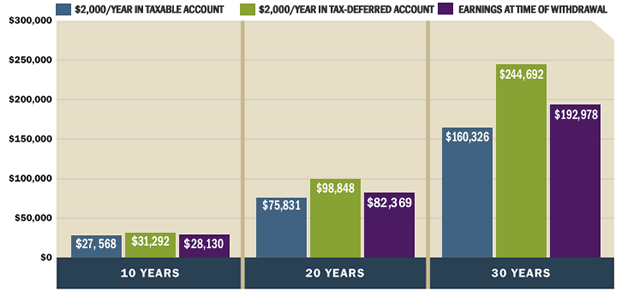Choosing Between Taxable And TaxDeferred Retirement Accounts
Post on: 23 Июнь, 2015 No Comment

Investors spend a great deal of time figuring out the proper asset allocation between stocks, bonds, real estate, and other asset classes. Financial planners also spend a lot of time gathering information on a clients risk tolerance level and goals in order to help with the asset allocation process. This is certainly one of the most important aspects of financial planning and shouldnt be taken lightly. However, many people fail to appreciate the importance of what some call a form of asset location, which is the process of deciding which investments will go in a taxable account vs. a tax-deferred account.
Studies conducted in 2005 by financial planners Gobind Daryanani and Chris Cordaro found that implementing asset location in a portfolio, versus equally dividing assets across taxable and IRA accounts, added 20 basis points of performance annually. If you take this 20 basis points and compound it over 30 to 40 years, the benefits can be quite large.
At first it might seem obvious that income-producing securities and funds, such as bonds, should go in tax-deferred accounts while lower tax capital gains-producing investments should go in taxable accounts. A study done by T. Rowe Price found that, not surprisingly, the higher your tax bracket in retirement- when distributions are taxed at ordinary income tax rates- the more beneficial it is to put bond funds in a tax-deferred account and equity funds in a taxable account.
However, if an investor is in a lower tax bracket and has a long holding period (10 years or more), he can do better by keeping stock funds in the tax-deferred account and bond funds in the taxable account. This is due to the combination of having a lower tax rate on the income from bonds as well as the fact that the equities in the tax-deferred account can grow for many years tax-deferred at presumably a higher growth rate than bonds. The compounding of these higher growth rates over time can be substantial.
Its also interesting to think about different types of stocks and how their characteristics can affect your taxes and portfolio value in the future. Large-capitalization growth equity funds generally have lower turnover and smaller dividends than small-cap value stocks, which means they can be more tax-efficient in a taxable account.
Adding to the complexity of choosing how to allocate your funds between taxable and tax-deferred accounts is the ever-changing tax code. As of now, personal income tax rates and long-term capital gains rates are scheduled to increase as of Jan. 1, 2013. Many also expected the 15% rate on qualified dividends to increase. So not only do investors and financial planners have to worry about how to allocate funds today, they have to attempt to predict the tax code in the future.
Disclosure: I have no positions in any stocks mentioned, and no plans to initiate any positions within the next 72 hours.














